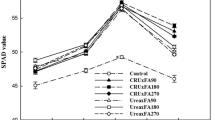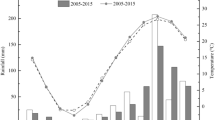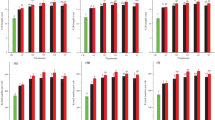Abstract
Efficient nitrogen (N) fertilizer management is critical for crop production and environmental sustainability. In cotton, however, a joint assessment of location-specific N management effects on agronomic performance and environmental impacts is still required to design a sustainable production system. Therefore, a 2-yr field study was conducted to investigate the response of cotton growth, yield, N use efficiency, changes in soil mineral N content (Nmin) and apparent N loss to different N management strategies in the Yellow River Valley of China. Fertilizer N treatments included split applications at sowing, the early flowering stage and the peak flowering stage respectively of 180-0-0, 108-72-0, 72-108-0, 72-72-36 and 72-36-72 kg N ha–1. The results showed that, on average, split-N increased shoot biomass by 15.5%, seed cotton yield by 5.8%, lint yield by 4.9%, and N uptake by 23.7%. The highest cotton yield, maximum growth rate, N uptake, and N use efficiencies were obtained with the application of 72 kg N ha−1 at sowing. Treatment of 72-36-72 resulted in a greater residual soil Nmin. In addition, apparent N loss was negatively correlated to the growth rate and N use efficiencies. Apparent N loss in single application was 48.3% of the total N, but split-N applications lowered it to 38.5%. Overall, we concluded that twice-split application with allocating more of N fertilizer to the early flowering stage contributes to a more sustainable cotton production for enhancing yield and N use efficiency while minimizing N loss.





Similar content being viewed by others
Abbreviations
- HI:
-
Harvest index
- N:
-
Nitrogen
- NHI:
-
Nitrogen harvest index
- NUE:
-
Nitrogen use efficiency
- NUpE:
-
Nitrogen uptake efficiency
- REN :
-
Nitrogen recovery efficiency
- AEN :
-
Agronomic nitrogen efficiency
- PFPN :
-
Nitrogen partial factor productivity
References
Abalos D, van Groenigen JW, Philippot L, Lubbers IM, De Deyn GB (2019) Plant trait-based approaches to improve nitrogen cycling in agroecosystems. J Appl Ecol 56:2454–2466. https://doi.org/10.1111/1365-2664.13489
Ameen A, Liu J, Han L, Xie GH (2019) Effects of nitrogen rate and harvest time on biomass yield and nutrient cycling of switchgrass and soil nitrogen balance in a semiarid sandy wasteland. Ind Crop Prod 136:1–10. https://doi.org/10.1016/j.indcrop.2019.04.066
Bao SD (2005) Analysis on Soil and Agricultural Chemistry. China Agricultural Press, Beijing, China (in Chinese)
Bonser SP (2013) High reproductive efficiency as an adaptive strategy in competitive environments. Funct Ecol 27:876–885. https://doi.org/10.1111/1365-2435.12064
Boschiero BN, Mariano E, Trivelin PCO (2018) “Preferential” ammonium uptake by sugarcane does not increase the 15N recovery of fertilizer sources. Plant Soil 429:253–269. https://doi.org/10.1007/s11104-018-3672-z
Cassman KG, Dobermann A, Walters DT (2002) Agroecosystems, nitrogen-use efficiency, and nitrogen management. Ambio 31:132–140. https://doi.org/10.1579/0044-7447-31.2.132
Cordeiro CFdS, Rodrigues DR, Echer FR (2022) Cover crops and controlled-release urea decrease need for mineral nitrogen fertilizer for cotton in sandy soil. Field Crops Res 276:108387. https://doi.org/10.1016/j.fcr.2021.108387
Cotton Research Institute Chinese Academy of Agricultural Sciences (2013) Cultivation of Cotton in China. Shanghai Science and Technology Press, Shanghai, China (in Chinese)
Cui Z, Zhang F, Chen X, Miao Y, Li J, Shi L, Xu J, Ye Y, Liu C, Yang Z, Zhang Q, Huang S, Bao D (2008) On-farm evaluation of an in-season nitrogen management strategy based on soil Nmin test. Field Crops Res 105:48–55. https://doi.org/10.1016/j.fcr.2007.07.008
Cui Z, Zhang F, Chen X, Dou Z, Li J (2010) In-season nitrogen management strategy for winter wheat: maximizing yields, minimizing environmental impact in an over-fertilization context. Field Crops Res 116:140–146. https://doi.org/10.1016/j.fcr.2009.12.004
Cui Z, Yue S, Wang G, Meng Q, Wu L, Yang Z, Zhang Q, Li S, Zhang F, Chen X (2013) Closing the yield gap could reduce projected greenhouse gas emissions: a case study of maize production in China. Global Change Biol 19:2467–2477. https://doi.org/10.1111/gcb.12213
Dong HZ, Li WJ, Eneji AE, Zhang DM (2012) Nitrogen rate and plant density effects on yield and late-season leaf senescence of cotton raised on a saline field. Field Crops Res 126:137–144. https://doi.org/10.1016/j.fcr.2011.10.005
Feng WN, Li XF, Dong HL, Qin YK, Sun M, Shao JJ, Zheng CS, Li PC (2022) Fruits-based critical nitrogen dilution curve for diagnosing nitrogen status in cotton. Front Plant Sci 13:801968. https://doi.org/10.3389/fpls.2022.801968
Geng J, Ma Q, Zhang M, Li C, Liu Z, Lyu X, Zheng W (2015) Synchronized relationships between nitrogen release of controlled release nitrogen fertilizers and nitrogen requirements of cotton. Field Crops Res 184:9–16. https://doi.org/10.1016/j.fcr.2015.09.001
Hou X, Xiang Y, Fan J, Zhang F, Hu W, Yan F, Guo J, Xiao C, Li Y, Cheng H, Li Z (2021) Evaluation of cotton N nutrition status based on critical N dilution curve, N uptake and residual under different drip fertigation regimes in Southern Xinjiang of China. Agric Water Manage 256:107134. https://doi.org/10.1016/j.agwat.2021.107134
Hu C, Sadras VO, Lu G, Zhang P, Han Y, Liu L, Xie J, Yang X, Zhang S (2021) A global meta-analysis of split nitrogen application for improved wheat yield and grain protein content. Soil Till Res 213:105111. https://doi.org/10.1016/j.still.2021.105111
Jiang Q, Madramootoo CA, Qi Z (2022) Soil carbon and nitrous oxide dynamics in corn (Zea mays L.) production under different nitrogen, tillage and residue management practices. Field Crops Res 277:108421. https://doi.org/10.1016/j.fcr.2021.108421
Ju XT, Xing GX, Chen XP, Zhang SL, Zhang LJ, Liu XJ, Cui ZL, Yin B, Christie P, Zhu ZL, Zhang FS (2009) Reducing environmental risk by improving N management in intensive Chinese agricultural systems. Proc Natl Acad Sci USA 106:3041–3046. https://doi.org/10.1073/pnas.0813417106
Kabir T, De Laporte A, Nasielski J, Weersink A (2021) Adjusting nitrogen rates with split applications: modelled effects on N losses and profits across weather scenarios. Eur J Agron 129:126328. https://doi.org/10.1016/j.eja.2021.126328
Li XF, Han YC, Wang GP, Feng L, Wang ZB, Yang BF, Du WL, Lei YP, Xiong SW, Zhi XY, Xing FF, Fan ZY, Xin MH, Li YB (2020) Response of cotton fruit growth, intraspecific competition and yield to plant density. Eur J Agron 114:125991. https://doi.org/10.1016/j.eja.2019.125991
Li XF, Lei YP, Han YC, Wang ZB, Wang GP, Feng L, Du WL, Fan ZY, Yang BF, Xiong SW, Xing FF, Xin MH, Li YB (2021) The relative impacts of changes in plant density and weather on cotton yield variability. Field Crops Res 270:108202. https://doi.org/10.1016/j.fcr.2021.108202
Liu A, Li Z, Zhang D, Cui Z, Zhan L, Xu S, Zhang Y, Dai J, Li W, Nie J, Yang G, Li C, Dong H (2022a) One-off basal application of nitrogen fertilizer increases the biological yield but not the economic yield of cotton in moderate fertility soil. Field Crops Res 288:108702. https://doi.org/10.1016/j.fcr.2022.108702
Liu A, Ma X, Zhang Z, Liu J, Luo D, Yang L, Lv N, Zhang Y, Yang G, Dong H (2022b) Single dose fertilization at reduced nitrogen rate improves nitrogen utilization without yield reduction in late-planted cotton under a wheat-cotton cropping system. Ind Crop Prod 176:114346. https://doi.org/10.1016/j.indcrop.2021.114346
Malone RW, Ma L, Heilman P, Karlen DL, Kanwar RS, Hatfield JL (2007) Simulated N management effects on corn yield and tile-drainage nitrate loss. Geoderma 140:272–283. https://doi.org/10.1016/j.geoderma.2007.04.011
Mendiburu, F., 2021. Agricolae: statistical procedures for agricultural research. R package version 1.3–5.
Mittermayer M, Maidl F-X, Nätscher L, Hülsbergen K-J (2022) Analysis of site-specific N balances in heterogeneous croplands using digital methods. Eur J Agron 133:126442. https://doi.org/10.1016/j.eja.2021.126442
Pinheiro J, Bates D, DebRoy S, Sarkar D, R Core Team (2020) nlme: linear and nonlinear mixed effects models. R package version 3.1–144
R Core Team (2020) R: a language and environment for statistical computing. R Foundation for Statistical Computing, Vienna
Scheer C, Rowlings DW, Antille DL, Migliorati MD, Fuchs K, Grace PR (2022) Improving nitrogen use efficiency in irrigated cotton production. Nutr Cycl Agroecosyst. https://doi.org/10.1007/s10705-022-10204-6
Sinclair TR, Rufty TW (2012) Nitrogen and water resources commonly limit crop yield increases, not necessarily plant genetics. Glob Food Secur 1:94–98. https://doi.org/10.1016/j.gfs.2012.07.001
Souza EFC, Soratto RP, Sandaña P, Venterea RT, Rosen CJ (2020) Split application of stabilized ammonium nitrate improved potato yield and nitrogen-use efficiency with reduced application rate in tropical sandy soils. Field Crops Res 254:107847. https://doi.org/10.1016/j.fcr.2020.107847
Takeda N, Friedl J, Rowlings D, De Rosa D, Scheer C, Grace P (2021) No sugar yield gains but larger fertiliser 15N loss with increasing N rates in an intensive sugarcane system. Nutr Cycl Agroecosyst 121:99–113. https://doi.org/10.1007/s10705-021-10167-0
Wang M, Wang L, Cui Z, Chen X, Xie J, Hou Y (2017) Closing the yield gap and achieving high N use efficiency and low apparent N losses. Field Crops Res 209:39–46. https://doi.org/10.1016/j.fcr.2017.03.016
Wang D, Xu C, Ye C, Chen S, Chu G, Zhang X (2018) Low recovery efficiency of basal fertilizer-N in plants does not indicate high basal fertilizer-N loss from split-applied N in transplanted rice. Field Crops Res 229:8–16. https://doi.org/10.1016/j.fcr.2018.09.008
Wang Z, Wang Z, Ma L, Lv X, Meng Y, Zhou Z (2021) Straw returning coupled with nitrogen fertilization increases canopy photosynthetic capacity, yield and nitrogen use efficiency in cotton. Eur J Agron 126:126267. https://doi.org/10.1016/j.eja.2021.126267
Yan XY, Ti CP, Vitousek P, Chen DL, Leip A, Cai ZC, Zhu ZL (2014) Fertilizer nitrogen recovery efficiencies in crop production systems of China with and without consideration of the residual effect of nitrogen. Environ Res Lett 9:095002. https://doi.org/10.1088/1748-9326/9/9/095002
Yan XY, Xia LL, Ti CP (2022) Temporal and spatial variations in nitrogen use efficiency of crop production in China. Environ Pollut 293:118496. https://doi.org/10.1016/j.envpol.2021.118496
Yang GZ, Tang HY, Nie YC, Zhang XL (2011) Responses of cotton growth, yield, and biomass to nitrogen split application ratio. Eur J Agron 35:164–170. https://doi.org/10.1016/j.eja.2011.06.001
Yang GZ, Tang HY, Tong J, Nie YC, Zhang XL (2012) Effect of fertilization frequency on cotton yield and biomass accumulation. Field Crops Res 125:161–166. https://doi.org/10.1016/j.fcr.2011.08.008
Yang GZ, Chu KY, Tang HY, Nie YC, Zhang XL (2013) Fertilizer 15N accumulation, recovery and distribution in cotton plant as affected by N rate and split. J Integr Agric 12:999–1007. https://doi.org/10.1016/S2095-3119(13)60477-3
Yin X, Goudriaan JAN, Lantinga EA, Vos JAN, Spiertz HJ (2003) A flexible sigmoid function of determinate growth. Ann Bot 91:361–371. https://doi.org/10.1093/aob/mcg029
Zhang D, Li W, Xin C, Tang W, Eneji AE, Dong H (2012a) Lint yield and nitrogen use efficiency of field-grown cotton vary with soil salinity and nitrogen application rate. Field Crops Res 138:63–70. https://doi.org/10.1016/j.fcr.2012.09.013
Zhang FS, Cui ZL, Chen XP, Ju XT, Shen JB, Chen Q, Liu XJ, Zhang WF, Mi GH, Fan MS, Jiang RF (2012b) Integrated nutrient management for food security and environmental quality in China. Adv Agron 116:1–40. https://doi.org/10.1016/B978-0-12-394277-7.00001-4
Zhang X, Davidson EA, Mauzerall DL, Searchinger TD, Dumas P, Shen Y (2015) Managing nitrogen for sustainable development. Nature 528:51–59. https://doi.org/10.1038/nature15743
Zhang G, Zhao D, Liu S, Liao Y, Han J (2022) Can controlled-release urea replace the split application of normal urea in China? a meta-analysis based on crop grain yield and nitrogen use efficiency. Field Crops Res 275:108343. https://doi.org/10.1016/j.fcr.2021.108343
Zhao RF, Chen XP, Zhang FS, Zhang HL, Schroder J, Römheld V (2006) Fertilization and nitrogen balance in a wheat-maize rotation system in North China. Agron J 98:938–945. https://doi.org/10.2134/agronj2005.0157
Funding
This study was funded by the National Key Research and Development Program of China (grant number 2017YFD0200107) and the Agricultural Science and Technology Innovation Program of Chinese Academy of Agricultural Sciences.
Author information
Authors and Affiliations
Corresponding authors
Ethics declarations
Conflict of interest
The authors declare that they have no conflict of interest.
Ethical approval
This article does not contain any studies with human participants or animals performed by any of the authors.
Additional information
Publisher's Note
Springer Nature remains neutral with regard to jurisdictional claims in published maps and institutional affiliations.
Supplementary Information
Below is the link to the electronic supplementary material.
Rights and permissions
Springer Nature or its licensor (e.g. a society or other partner) holds exclusive rights to this article under a publishing agreement with the author(s) or other rightsholder(s); author self-archiving of the accepted manuscript version of this article is solely governed by the terms of such publishing agreement and applicable law.
About this article
Cite this article
Feng, W., Li, P., Zheng, C. et al. Split-nitrogen application increases nitrogen-use efficiency and yield of cotton. Nutr Cycl Agroecosyst 125, 393–407 (2023). https://doi.org/10.1007/s10705-023-10267-z
Received:
Accepted:
Published:
Issue Date:
DOI: https://doi.org/10.1007/s10705-023-10267-z




